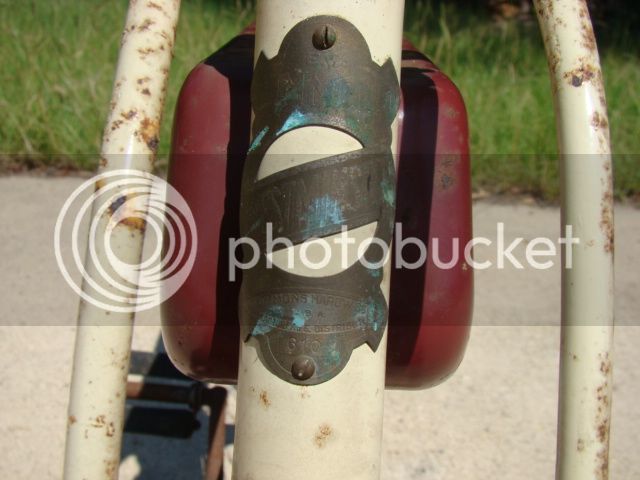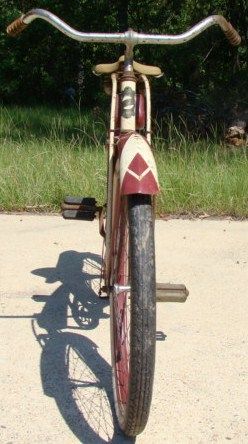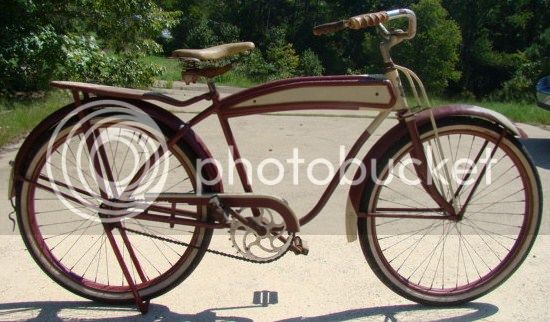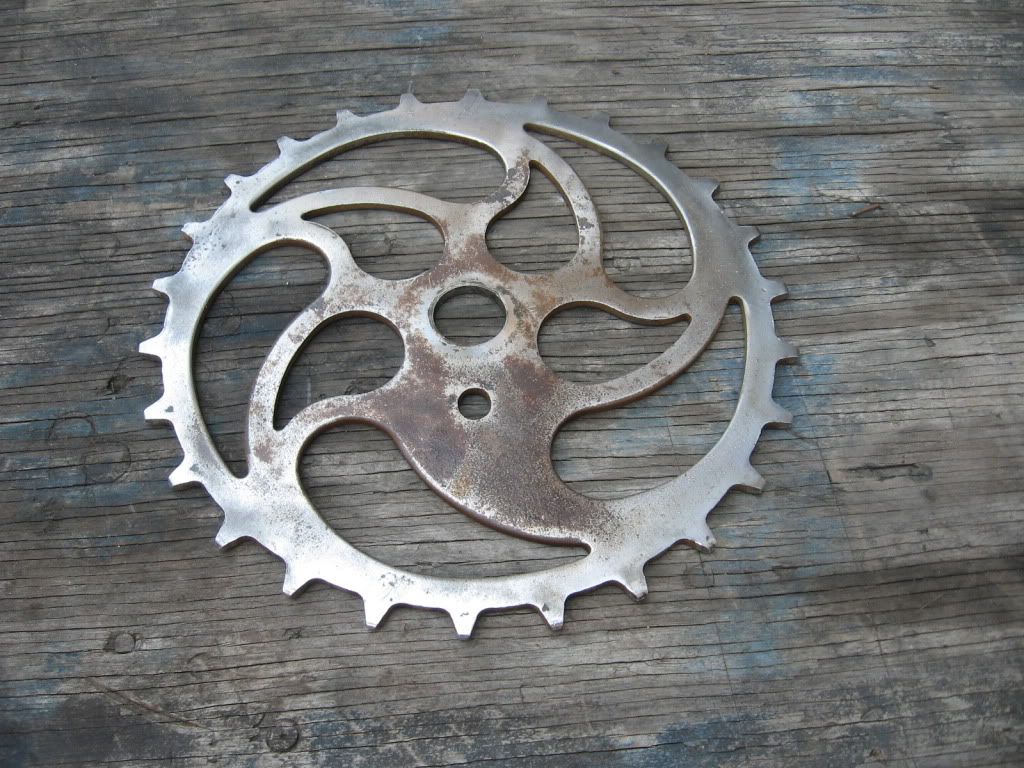You are using an out of date browser. It may not display this or other websites correctly.
You should upgrade or use an alternative browser.
You should upgrade or use an alternative browser.
Monark or CWC
- Thread starter Warrior4Christ
- Start date

Help Support Rat Rod Bikes Bicycle Forum:
This site may earn a commission from merchant affiliate
links, including eBay, Amazon, and others.
The question of manufacture for this bike has been discussed in several threads now. It has been noted that this bike has been refurbished at some time and it points to the danger of trying to identify any bike by its components. This bike appears to be of mostly original content but some bikes that look so are truly built from parts that were never part of a factory arranged marriage. In such cases of mixed ancestry I believe the identity goes with the frame so this bike is a Monark.
The only part of this bike that is CWC sourced is the chainring. It has been noted that while similar in appearance the CWC chainrings are one-inch pitch and 3/16-inch plate while the Monark rings are ½-inch pitch and 1/8” thick and dished. There is no known factory connection between CWC and Monark so the appearance of the CWC chainring on this bike logically is due to a post-purchase swap at some point in time. It is unusual to find a bike that would have originally been ½-inch drive converted to 1-inch pitch. There is no advantage in 1-inch pitch and chain has been difficult and expensive to come by for a long time now so 1950’s-80’s swaps typically went the other way. This probably means the swap occurred early when both systems were still viable or recently when running 1-inch pitch drivelines has become “cool”.
Other than the chainring (and hence some of the rest of the drive line) and a few sundries like the grips, the bike is 100% Monark.
The frame is a version of the Monark “Rocket” frame. Versions of this frame date back to about 1939 but the frame was modified in 1941 assuming a “DX” configuration with two curved top tube closing toward the rear. (I have heard it mentioned that the opening is very close to that of a contemporary Schwinn “DX” and that the tanks will physically interchange.)
The tank is also a Monark specific tank. Monark produced at least two different tanks that fit this frame; one has side bulges as opposed to the flat sides of this version. The bulged version does not appear to have been used after the war but the flat version was used into the 1950’s.
The Fenders are also Monark specific. They are gothic (ridged) like CWC fenders but next to each other there would be no other similarities. The clearest difference is the long forward overhang which was never used by CWC. They are also quite shallow as are most prewar Monark fenders. (Perhaps the long term savings in sheet metal was called into service when the ultra-deep fenders were introduced after the war.)
As for dating the bike, It is likely not older than 1941 and probably not any newer than circa 1950. I have noticed that virtually all of the postwar Monark bikes do not retain dropstand tangs so I would guess the frame dates to 1941/42; the serial number may help narrow that down.
The only part of this bike that is CWC sourced is the chainring. It has been noted that while similar in appearance the CWC chainrings are one-inch pitch and 3/16-inch plate while the Monark rings are ½-inch pitch and 1/8” thick and dished. There is no known factory connection between CWC and Monark so the appearance of the CWC chainring on this bike logically is due to a post-purchase swap at some point in time. It is unusual to find a bike that would have originally been ½-inch drive converted to 1-inch pitch. There is no advantage in 1-inch pitch and chain has been difficult and expensive to come by for a long time now so 1950’s-80’s swaps typically went the other way. This probably means the swap occurred early when both systems were still viable or recently when running 1-inch pitch drivelines has become “cool”.
Other than the chainring (and hence some of the rest of the drive line) and a few sundries like the grips, the bike is 100% Monark.
The frame is a version of the Monark “Rocket” frame. Versions of this frame date back to about 1939 but the frame was modified in 1941 assuming a “DX” configuration with two curved top tube closing toward the rear. (I have heard it mentioned that the opening is very close to that of a contemporary Schwinn “DX” and that the tanks will physically interchange.)
The tank is also a Monark specific tank. Monark produced at least two different tanks that fit this frame; one has side bulges as opposed to the flat sides of this version. The bulged version does not appear to have been used after the war but the flat version was used into the 1950’s.
The Fenders are also Monark specific. They are gothic (ridged) like CWC fenders but next to each other there would be no other similarities. The clearest difference is the long forward overhang which was never used by CWC. They are also quite shallow as are most prewar Monark fenders. (Perhaps the long term savings in sheet metal was called into service when the ultra-deep fenders were introduced after the war.)
As for dating the bike, It is likely not older than 1941 and probably not any newer than circa 1950. I have noticed that virtually all of the postwar Monark bikes do not retain dropstand tangs so I would guess the frame dates to 1941/42; the serial number may help narrow that down.
dogdart said:I have seen Monarks equipped with skip tooth sprockets , that definitely appear to be from the factory .
I should have noted that I am referring specifically to the "double paisley" sprockets which look similar in pattern but are all 1/8-inch, 1/2-inch pitch for Monarks and 3/16-inch, 1-inch pitch for CWC. If these sprockets are cross purposed then it is indicative of a post factory swap-out. More broadly, Monark did equip their earliest Aluminum bicycles with 1-inch pitch drivelines (Typically with Sweetheart pattern chainrings, never with CWC pattern rings) before they developed their own 1/2-inch pitch chainring.
dogdart said:There's an aluminum Monark on ebay now with this ring , I parted a Monark out a few years ago with one , and here's a pic from Dave's Nostalgic of an original appearing Monark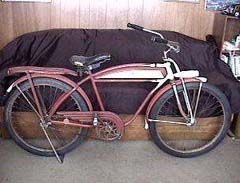
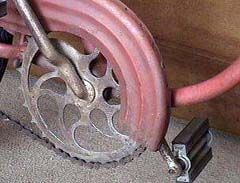
Besides the bike in this thread you mention three Monarks fitted with 1-inch “double paisley’ sprockets.
I assume that this bike:
http://www.ebay.com/itm/1939-MONARK-SIL ... 2ec2a9d9d6
is the eBay reference you are citing. While the seller spins a tempting tale about the bike my opinion viewing this bike is that it, (and probably the story,) is best described as malarkey.
Several things about the bike are quite wrong so it is not a good reference regarding the chainring. (It reminds me of a bike built by a local, 25 years ago, that was based on fitting 26 inch tires in a 24 inch frame. In that case deep steel postwar fenders were hot sprayed with aluminum and polished.)
I can’t comment on your parted bike but the bike in this tread and the bike on nostalgic.net are both versions of the Monark Rocket frame fitted with 1-inch pitch double paisley chain rings. Neither of the photos is very clear, but the nostalgic net picture seems to show the typical drilling provided to mount the Monark pie plate chainring. If I am reading that photo correctly, it is the most telling evidence that Monark may have offered a 1-inch pitch paisley ring. The ring in the Nostalgic.net photo also looks somewhat different than a CWC ring (sharper edges, and thinner?) which brings up a slew of questions that are hard to answer without a real side by side comparison.
So, thank you for piquing my curiosity on this subject, and I will look for more evidence or clear examples of a 1-inch pitch Monark paisley ring in the future. It is still a general fallacy to base conclusions on what looks original to a bike now, because every bike looked brand new when it left the factory. If a change was made to the bike early on by the original owner, all the matching patina would have occurred after the modification. Unfortunately the same circumstances can mask the true rare anomalies in the hobby so it is always best to keep an open mind and be careful using always and never in an historic description.
dogdart said:I will get some pics of the chain ring I have for comparison to CWC ring .
Excellent! Thanks, the war is won in small discoveries.




